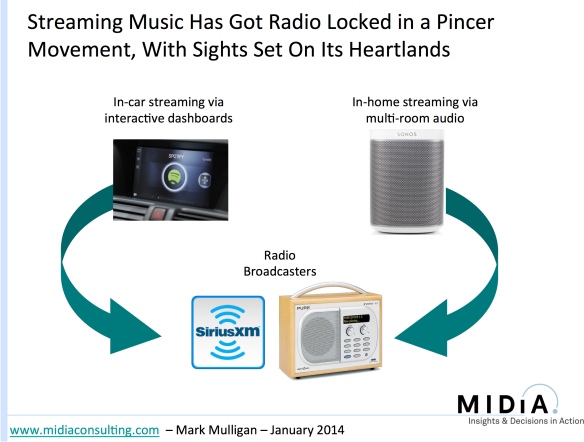2014 will be another year of growth and of controversy for streaming, with much of the debate set to focus on
how streaming may, or may not, cannibalize download sales. The
evidence from Sweden and from the US so far suggests that streaming revenues may indeed grow at the direct expense of downloads. But while we may be some way off from a definitive judgment on that issue, there is one cannibalization threat that is looking increasingly incontrovertible, yet has got far less attention: the cannibalization of radio. In fact radio faces a two-pronged attack on its two heartlands, the home and the car.
The Home Front
There are many forms of streaming service and each sub-segment is eager to declare its uniqueness. Spotify and Pandora practically fall over themselves to explain how different they are. And indeed, in many ways they are, but what they have in common is that they are both direct competitors for radio listening time. While they do not compete for all radio listening, nor for all radio listeners, they compete for much of the listening of some of the most valuable listeners. Indeed streaming is looking more like radio with every passing day. The intensifying focus on curation as a means of making sense of 30 million songs is leading to on-demand services delivering a richer suite of lean-back, programmed and semi-programmed experiences. In doing so the competitive threat to radio intensifies. Whereas radio broadcasters can rightly claim that radio delivers a low effort, lean back listening experience, streaming services now wear those clothes too and they are not going to relinquish them.
Where things have really heated up though is the surge in streaming playback technology for the home. Companies like Sonos and Pure have pioneered in-home streaming technology and CES saw this whole sector upping its game. Music hi-fi is disappearing out of the home and these companies plan to bring it back with streaming at its core. While radio is a key component of these devices, any hardware that gives a user the choice between traditional radio and interactive streaming is going to mean that radio is directly competing for listening time on that very device. The home is one of radio’s heartlands, and broadcasters are now having to fend off the unwanted attentions of streaming music services establishing an in-home beachhead with consumer adoption of home streaming devices.
Digital Radio Fragmentation Plays Into the Hands of Streaming Services
Dedicated digital radio devices such as DAB and satellite radio players have only found traction in a handful of markets, with the US and UK notable exceptions at the forefront. But international and domestic squabbles over competing digital radio standards mean that the global digital radio landscape is a fragmented mess of half-baked trials and aborted roll outs. All the while internet streaming adoption accelerates on smartphones and tablets. Radio may even buckle under the weight of this app invasion. The more radio broadcasters rely on internet streaming for digital strategy, the more they put themselves directly in competition with streaming services, both on-demand and interactive radio.
The Battle for the Car
If the onslaught on the home was not enough, the growth of interactive car dashboards means that streaming services are getting straight into the car too. In the US SiriusXM has long been held up as a standout success story for digital content with 25.6 million paying subscribers outshining any on demand music service by a country mile. But the same app invasion that is threating radio on smartphones and tablets is now pouring into the car via interactive dashboards. Car manufacturers are striking up deals at a bewildering rate with streaming providers with Pandora and Spotify being particularly active. SiriusXM had a decent run at things, offering a truly national radio experience in the US, but now more and more consumers will start wondering why they need to pay $15 a month when they can get Pandora and Songza for free.
The Free Music Land Grab
Thus radio finds itself locked in a streaming music technology pincer movement that threatens it like never before. Radio broadcasters have countless assets at their disposal – talk radio, DJs, market-leading programming expertise – but they cannot rely on these alone anymore. They have to up their innovation ante posthaste. They also face a further and utterly crucial disruptive threat from streaming: the free music land grab.
Spotify and Apple only offer free music as a means to sell their core products. Advertising revenue is a nice way of covering some costs but is not their lifeblood in the way it is for commercial broadcasters. This means that they can be more cavalier in their ad sales strategies and undercut radio broadcasters for business with rates that might not be sustainable for a commercial broadcaster. 2014 will see these two powerhouses
pursue aggressive advertiser strategies and when coupled with
Pandora’s burgeoning ad sales record, traditional broadcasters may find themselves becoming collateral damage in the free music land grab.
Is 2014 a Napster Year for Radio?
2014 will be an important year for streaming, but it will be even more pivotal for radio. It is far too early in the development of streaming to say that this is a make or break year for radio, but it is fair to say that 2014 looks and smells for radio a lot like 1999 did for the music industry. Back then the labels failed to respond to Napster with innovation and they spent the next decade paying the price. Radio broadcasters would be well served to –learn from the labels’ mistake.


